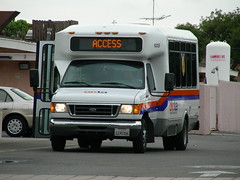In the first part of this series I discuss what was done with the regular bus network in order to comply with the Americans with Disabilities Act. Now its time to discuss the other part of the puzzle, the Paratransit service called Flextrans here in Utah.
The Anti-Hunger Coalition and its band of yellow shirts and the Transit Riders Union both try to portray TRAX as the reason why bus service is being slashed. It is an easy target for those who do not look closely and the numbers and truly sees what is happening. However, TRAX is not to blame when it comes to the cutting of bus service. Just take a look at some of these financial numbers
Just a note: I am using numbers from UTA’s 2006 budget. So that no one could say the ridership numbers were too high, I cut the actual ridership numbers on TRAX by 20% but left the others alone. Of course the some would argue that UTA is padding the numbers but the numbers are in line with transit systems across the nation and the world.
I also want to point out that I am NOT saying Flextrans is not needed, I am just pointing out the cost of the system compared to the rest of the transit system.
So here are some numbers to think about. Looking at costs vs. passengers, TRAX cost $1.37 per passenger. So in other words TRAX is covering its above the rail expenses (meaning direct operating cost) and contributing to overhead. This makes TRAX the second most efficient light rail system getting beat only by San Diego. However, the numbers are in line with the other systems as they are very close with the exception of Los Angeles but that is another story.
On the other hand, it cost $3.31 per passenger on the bus system. So not only is it not covering its direct operating cost, it is not contributing to overhead. This is one an area that UTA can improve since it is one of the more performing systems.
Finally you have Paratransit service. It cost $24.95 per passenger for every passenger that boards the Paratransit service. To put this in perspective if UTA did not have to provide Paratransit service, bus service could be increased 17% percent overnight. In addition Paratransit handles only 4% of the numbers TRAX does and 2.5% of the bus system.
So as you can see, what is costing the bus system is carrying the weight of the Paratransit service not TRAX.
Now the ADA was designed to give those that needed it, equal access which is a good goal. However, wasn’t equal access created by putting wheelchair lifts or the creation of low floor buses? This gives everyone the same access to transit service to everyone. However, the requirement for Paratransit service creates special services that everyone else is not entitled to ride.
Since Paratransit service is needed by those who use it, but is essentially a taxi cab social service, should the transit system budget be responsible to take care of it? Or should it be the responsibility of the social services agencies?
We also know how the Paratransit passengers screamed when UTA started requiring them to pay more for there services than regular bus service (although the amount of difference has dwindled). Should Paratransit riders be expected to pay more for the premium service they require?
These are not easy questions to answer.

No comments:
Post a Comment